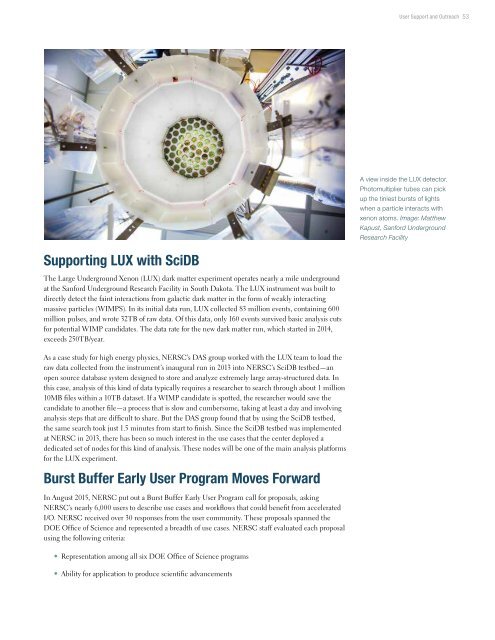National Energy Research Scientific Computing Center
BcOJ301XnTK
BcOJ301XnTK
Create successful ePaper yourself
Turn your PDF publications into a flip-book with our unique Google optimized e-Paper software.
User Support and Outreach 53<br />
A view inside the LUX detector.<br />
Photomultiplier tubes can pick<br />
up the tiniest bursts of lights<br />
when a particle interacts with<br />
xenon atoms. Image: Matthew<br />
Kapust, Sanford Underground<br />
<strong>Research</strong> Facility<br />
Supporting LUX with SciDB<br />
The Large Underground Xenon (LUX) dark matter experiment operates nearly a mile underground<br />
at the Sanford Underground <strong>Research</strong> Facility in South Dakota. The LUX instrument was built to<br />
directly detect the faint interactions from galactic dark matter in the form of weakly interacting<br />
massive particles (WIMPS). In its initial data run, LUX collected 83 million events, containing 600<br />
million pulses, and wrote 32TB of raw data. Of this data, only 160 events survived basic analysis cuts<br />
for potential WIMP candidates. The data rate for the new dark matter run, which started in 2014,<br />
exceeds 250TB/year.<br />
As a case study for high energy physics, NERSC’s DAS group worked with the LUX team to load the<br />
raw data collected from the instrument’s inaugural run in 2013 into NERSC’s SciDB testbed—an<br />
open source database system designed to store and analyze extremely large array-structured data. In<br />
this case, analysis of this kind of data typically requires a researcher to search through about 1 million<br />
10MB files within a 10TB dataset. If a WIMP candidate is spotted, the researcher would save the<br />
candidate to another file—a process that is slow and cumbersome, taking at least a day and involving<br />
analysis steps that are difficult to share. But the DAS group found that by using the SciDB testbed,<br />
the same search took just 1.5 minutes from start to finish. Since the SciDB testbed was implemented<br />
at NERSC in 2013, there has been so much interest in the use cases that the center deployed a<br />
dedicated set of nodes for this kind of analysis. These nodes will be one of the main analysis platforms<br />
for the LUX experiment.<br />
Burst Buffer Early User Program Moves Forward<br />
In August 2015, NERSC put out a Burst Buffer Early User Program call for proposals, asking<br />
NERSC’s nearly 6,000 users to describe use cases and workflows that could benefit from accelerated<br />
I/O. NERSC received over 30 responses from the user community. These proposals spanned the<br />
DOE Office of Science and represented a breadth of use cases. NERSC staff evaluated each proposal<br />
using the following criteria:<br />
• Representation among all six DOE Office of Science programs<br />
• Ability for application to produce scientific advancements


